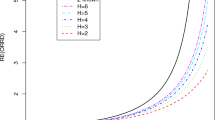Abstract
Insect-vectored plant diseases impact the agricultural community each year by affecting the economic value, the quantity, and the quality of crops. Controlling the spread of disease is an important area in risk assessment, and understanding the dynamics of vector populations helps researchers to develop effective treatments. In this article, we consider an experimental design commonly used by researchers who study plant disease and examine large-sample, likelihood-based hypothesis tests that can be used to characterize disease-transmission behavior in a stratified population. Small-sample size and power results along with design considerations are provided. We illustrate our testing procedures using two real data examples and provide recommendations for plant-disease researchers in the field.
Similar content being viewed by others
References
Atkinson, A., and Lawrance, A. (1989), “A Comparison of Asymptotically Equivalent Test Statistics for Regression Transformation,” Biometrika, 76, 223–229.
Chen, C., and Swallow, W. (1990), “Using Group Testing to Estimate a Proportion, and to Test the Binomial Model,” Biometrics, 46, 1035–1046.
— (1995), “Sensitivity Analysis of Variable-Size Group Testing and its Related Continuous Models,” Biometrical Journal, 2, 173–181.
Cox, D., and Hinkley, D. (1974), Theoretical Statistics, London: Chapman and Hall.
Desbiez, C., and LeCoq, H. (1997), “Zucchini Yellow Mosaic Virus,” Plant Pathology, 46, 809–829.
Dorfman, R. (1943), “The Detection of Defective Members of Large Populations,” Annals of Mathematical Statistics, 14, 436–440.
Evers, E., and Nauta, M. (2001), “Estimation of Animal-Level Prevalence from Pooled Samples in Animal Production,” Preventive Veterinary Medicine, 49, 175–190.
Gastwirth, J. (2000), “The Efficiency of Pooling in the Detection of Rare Mutations,” American Journal of Human Genetics, 67, 1036–1039.
Gastwirth, J., and Johnson, W. (1994), “Screening with Cost-Effective Quality Control: Potential Applications to HIV and Drug Testing,” Journal of the American Statistical Association, 89, 972–981.
George, V., Johnson, W., Shahane, A., and Nick, T. (1997), “Testing for Treatment Effect in the Presence of Regression Toward the Mean,” Biometrics, 53, 49–59.
Hepworth, G. (1996), “Exact Confidence Intervals for Proportions Estimated by Group Testing,” Biometrics, 52, 1134–1146.
— (2005), “Confidence Intervals for Proportions Estimated by Group Testing with Groups of Unequal Size,” Journal of Agricultural, Biological, and Environmental Statistics, 10, 478–497.
Hughes-Oliver, J., and Swallow, W (1994), “A Two-Stage Adaptive Procedure for Estimating Small Proportions,” Journal of the American Statistical Association, 89, 982–993.
Kim, D., and Taylor, D. (1995), “The Restricted EM Algorithm for Maximum Likelihood Estimation under Linear Restrictions on the Parameters,” Journal of the American Statistical Association, 90, 708–716.
Kishaba, A., Castle, S., Coudriet, D., McCreight, J., and Bohn, G. (1992), “Virus Transmission by Aphis gossypii Glover to Aphid-Resistant and Susceptible Muskmelons,” Journal of the American Society for Horticultural Science, 117, 248–254.
Lenardon, S., March, G., Nome, S., and Ornaghi, J. (1998), “Recent Outbreak of ‘Mal de Rio Cuarto’ Virus on Corn in Argentina,” Plant Disease, 82, 448.
Le, C. (1981), “A New Estimator for Infection Rates using Pools of Variable Size,” American Journal of Epidemiology, 114, 132–136.
Louis, T. (1982), “Finding Observed Information using the EM Algorithm,” Journal of the Royal Statistical Society, Series B, 44, 98–130.
March, G., Balzarini, M., Ornaghi, J., Beviacqua, J., and Marinelli, A. (1995), “Predictive Model for ‘Mal de Rio Carto’ Disease Intensity,” Plant Disease, 79, 1051–1053.
McCann, M., and Tebbs, J., (2007), “Pairwise Comparisons for Proportions Estimated by Pooled Testing,” Journal of Statistical Planning and Inference, 137, 1278–1290.
Nettleton, D. (1999), “Convergence Properties of the EM Algorithm in Constrained Parameter Spaces,” The Canadian Journal of Statistics, 27, 639–648.
Ornaghi, J., March, G., Boito, G., Marinelli, A., Beviacqua, J., Giuggia, J., and Lenardon, S. (1999), “Infectivity in Natural Populations of Delphacodes kuscheli Vector of ‘Mal Rio Cuarto’ Virus,” Maydica, 44, 219–223.
Romanow, L., Moyer, J., and Kennedy, G. (1986), “Alteration of Efficiencies of Acquisition and Inoculation of Watermelon Mosaic Virus 2 by Plant Resistance to the Virus and to an Aphid Vector,” Phytopathology, 76, 1276–1281.
Rayner, J. (1997), “The Asymptotically Optimal Tests,” The Statistician, 46, 337–346.
Remlinger, K., Hughes-Oliver, J., Young, S., and Lam, R. (2006), “Statistical Design of Pools using Optimal Coverage and Minimal Collision,” Technometrics, 48, 133–143.
Serfling, R. (1980), Approximation Theorems of Mathematical Statistics, New York: Wiley.
Swallow, W. (1985), “Group Testing for Estimating Infection Rates and Probabilities of Disease Transmission,” Phytopathology, 75, 882–889.
Tebbs, J., and Bilder, C. (2004), “Confidence Interval Procedures for the Probability of Disease Transmission in Multiple-Vector Transfer Designs,” Journal of Agricultural, Biological, and Environmental Statistics, 9, 75–90.
Thierry-Mieg, N. (2006), “Pooling in Systems Biology Becomes Smart,” Nature Methods, 3, 161–162.
Vansteelandt, S., Goetghebeur, E., and Verstraeten, T. (2000), “Regression Models for Disease Prevalence with Diagnostic Tests on Pools of Serum Samples,” Biometrics, 56, 1126–1133.
Watson, M. (1936), “Factors Affecting the Amount of Infection Obtained by Aphis Transmission of the virus Hy. III,” Philosophical Transactions of the Royal Society of London, Series B, 226, 457–489.
Xie, M. (2001), “Regression Analysis of Group Testing Samples,” Statistics in Medicine, 20, 1957–1969.
Author information
Authors and Affiliations
Corresponding author
Rights and permissions
About this article
Cite this article
Tebbs, J.M., McCann, M.H. Large-sample hypothesis tests for stratified group-testing data. JABES 12, 534–551 (2007). https://doi.org/10.1198/108571107X250977
Received:
Revised:
Issue Date:
DOI: https://doi.org/10.1198/108571107X250977




